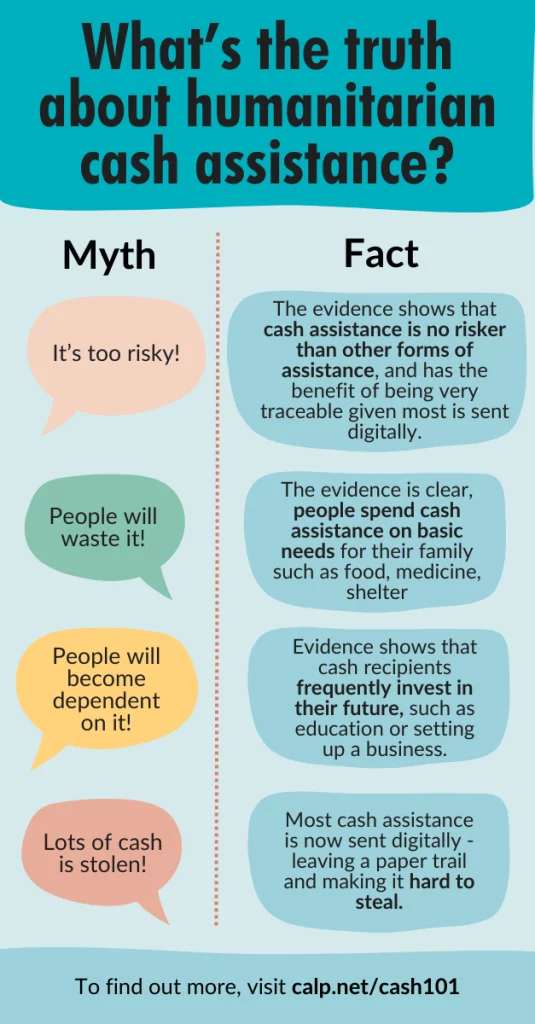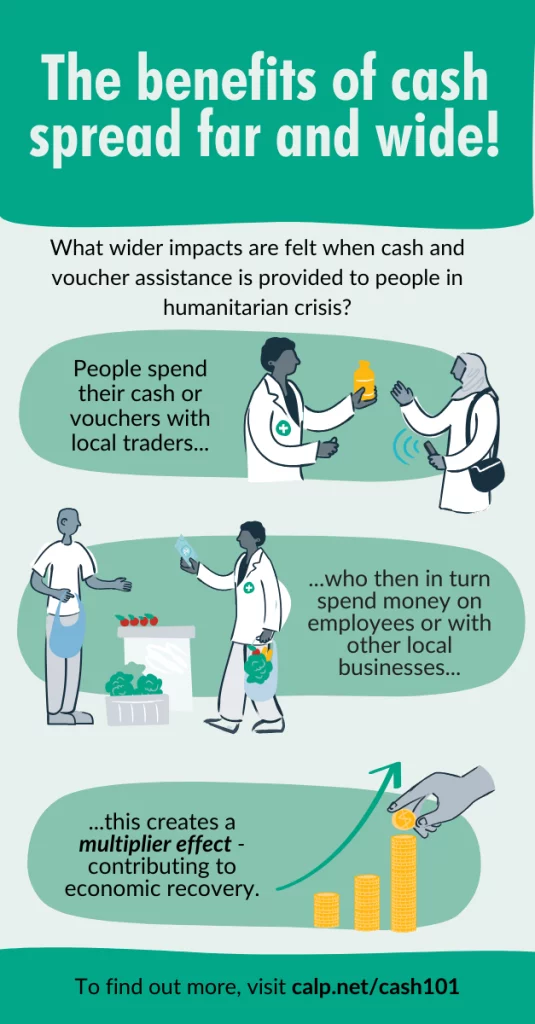The Risks of Cash and Voucher Assistance

Are there risks involved with cash and voucher assistance (CVA)?
Like any type of humanitarian aid, Cash and Voucher Assistance (CVA) presents risks and challenges. As such, it is important to identify potential risks and put in place mitigating measures to ensure people affected by crises receive safe and effective humanitarian assistance.
The misconception that CVA is riskier than other forms of aid could potentially hamper the growth of CVA programming, despite a strong body of evidence showing that this isn’t true. Many risks related to CVA are the same as in other types of humanitarian assistance.
CVA and risk – the facts

Fact 1: CVA is not inherently riskier than other forms of aid.
Contrary to popular belief, CVA isn’t inherently riskier than other forms of humanitarian assistance. This is because risks related to humanitarian assistance are often related to the context, rather than the type of aid being used.
In fact, while CVA carries similar risks to other forms of assistance, it often has the benefit of being easier to track when compared to in-kind goods and services. Furthermore, higher standards of monitoring and oversight are often applied to CVA which exposes risks related to all forms of assistance as well as CVA-specific risks.
Many risks can be easily mitigated. The best overall risk mitigation strategy is to involve potential recipients and community groups in the design of a CVA intervention to ensure it meets their needs and deals with the challenges they face. Practical examples of this people-centred approach are explained in this IFRC course.
Fact 2: CVA is more easily traceable than other forms of aid
CVA often allows for better traceability than in-kind assistance, allowing it to be subjected to much more rigorous monitoring. Using digital delivery processes, such as mobile money, means the flow of cash can be followed through to the intended recipients.
Fact 3: CVA is rarely wasted on items such as cigarettes and alcohol
Fears that cash transfers will be spent on ‘temptation goods’ such as alcohol or cigarettes are normally unfounded. Evidence shows people use cash to meet basic needs, improve the diversity of their diet, buy schoolbooks for their children, meet medical expenses, pay off debt, and other important expenses.
Fact 4: CVA reduces the chance of theft
Research shows that cash transfers are more likely to reach the intended recipients, compared to food aid. When digital cash is involved, there are fewer intermediaries than is the case for other forms of assistance, it’s more traceable, and can be delivered directly discretely to recipients’ bank accounts or mobile phones, in some cases without other community members knowing the person has received support.
Fact 5: CVA supports and boosts the local economy
Some people fear that providing people with cash and voucher assistance could disrupt local markets. Market assessments are used to ensure the market has the goods people are likely to want. The evidence shows that cash and voucher assistance boosts local markets with people spending money locally and so stimulating further investment by market traders and the local economy more broadly. This multiplier effect means that $1 spent by recipients of CVA can have an impact equivalent to between $1.5 and $2.13.
By contrast in-kind aid can disrupt local markets by introducing competing supplies.

Fact 6: Cash encourages people’s economic activity
Some people fear that cash transfers will lead to ‘laziness’, but that’s not the case. Research shows that cash transfers do not reduce the hours worked by recipients. Studies show that when these programs influence work levels, it’s typically in a positive direction.
Myth: you cannot just give people in poverty money. Truth: https://t.co/2Yj1Fp5yyf pic.twitter.com/hbSryPg3qM
— GiveDirectly💸 (@GiveDirectly) July 28, 2023
Mitigating the risks involved in CVA
As with any form of humanitarian aid, it is important to assess if CVA is an appropriate type of assistance for a specific response and consider the potential risks involved. Humanitarian actors have a duty of care to minimise any risks to the people they serve.
Risks and their mitigation measures
Here are some of the risks and mitigation measures that humanitarian actors can use.
Risk of Theft or diversion:
When CVA is taken by threat or force or given to unintended recipients.
Humanitarian actors can mitigate this by:
- Setting up systems that identify and register recipients
- Implementing recipient engagement systems, including complaints, feedback and response mechanisms
- Segregating duties across departments or individuals
- Considering whether it is appropriate to publicise disbursements
Risk of duplicating assistance or leaving gaps:
When a person is enrolled more than once in a programme, or conversely when people who are eligible for support are not included.
Humanitarian actors can mitigate this by:
- Speaking with other actors, such as humanitarian organisations, communities, authorities, government, and social protection stakeholders to coordinate their response
- Using context data to identify populations in need, particularly those not supported by other organisations
- Working with local, national and humanitarian structures to prevent undermining existing systems
- Participating in Cash Working Groups (CWGs)
Risk of abuse of power by Financial Service Provider (FSP) agents:
When FSP agents use their position to steal money from recipients, charge additional fees, deny services, or share recipients’ data.
Humanitarian actors can mitigate this by:
- Ensuring recipients know what to expect, when to expect it, and what their rights are
- Ensuring there are clear channels for people to raise concerns and have them addressed
- Designing the programme to include financial literacy training and information
- Ensuring resources are budgeted to actively manage the relationship with the FSP
- Ensuring FSPs’ responsibilities are reflected in their contract and cascaded to agents
- Promoting appropriate behaviour by FSP and their agents by including codes of conducts in contracts
- Being aware of FSPs’ sub-contractors to ensure agreements also reflect their contractual responsibilities and commitments to codes of conduct and ethical behaviours
- Working with development and social protection actors to identify initiatives they have with FSPs and agent networks that you could benefit from.
- Diversifying FSPs, taking information from FSP mappings undertaken by agencies or a CWG
Risk of safety and security of recipients, communities and staff:
When people’s safety and security could be threatened by the existence of a programme e.g., recipients having to travel long distances to access funds, tension when not all community members receive support or when staff must travel into insecure areas to administer the programme.
Humanitarian actors can mitigate this by:
- Working closely with protection actors and other implementing agencies to understand what measures others are taking.
- Holding discussions with vulnerable people to identify any risk they might face at each stage of the programme cycle
- Completing response analysis assessments (available in the CALP library)
Risk of data breaches:
When unauthorised individuals gain access to data collected for CVA.
Humanitarian actors can mitigate this by:
- Using CALP’s Data Responsibility Toolkit for relevant advice at each stage of the programme cycle.
- Completing a Data Protection Impact Assessment (DPIA)
- Collecting only the minimum amount of data really needed, encrypt it before it is stored and delete it once its purpose has been fulfilled.
- Signing Data Sharing Agreements with anyone supplying or receiving data
- Coordinating with other implementing agencies at the cluster and CWG level to ensure consistent data responsibility practices.
Risk of Influencing population movements:
When people move from areas without support into areas that may be covered by a CVA intervention.
Humanitarian actors can mitigate this by:
- Using the extensive targeting guidance that is available
- Working with authorities and communities in advance of distributions to manage expectations
- Being careful with public messaging to avoid creating pull-factors.
Risk of financing armed non-state actors or terrorism:
When people, normally authorities, perceive that CVA will support those who belong to armed non-state actors or be used to finance terrorism
Humanitarian actors can mitigate this by:
- Speaking to the authorities raising the question to understand their specific concerns.
- Ensuring a coordinated response by engaging with the humanitarian coordination bodies
- Following international and national Anti-Money Laundering (AML)/ Countering the Financing of Terrorism (CFT) guidance, which is summarised in a CALP report here.
Risk of CVA distributions could cause price rises or shortages of goods and services:
When a CVA distribution increases the amount of money in an area, leading to increased demand and price rises or shortages of goods and services
Humanitarian actors can mitigate this by:
- Completing a thorough market assessment prior to starting the intervention, using one of the tools in CALP’s Programme Quality Toolbox
- Considering the size of the local economy. In most cases inflation concerns are unfounded as the volume of humanitarian cash transfer are unlikely to be significant enough compared to other economic factors
Effective risk management is vital to any humanitarian programme – in some cases, the perception of risk is higher than the actual risk. And with effective mitigations, the risks can be as low or lower than other forms of aid.
Shifting mindsets from risk aversion to risk management is advisable to simplify decision making, and to achieve safe and impactful CVA interventions.